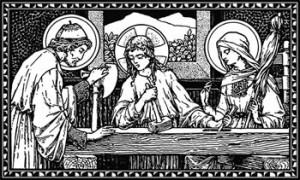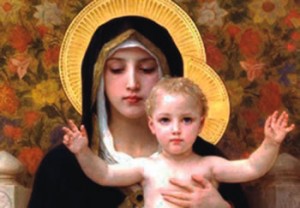Mary for Today for the Third Millennium (5)
Introduction
In 1975 Pope Paul VI observed that for many in the Church devotion to Mary was both a problem and on the wane. One main reason for this lay in the fact that our approach to Mary reflected outdated ideas of the Middle Ages and Counter-Reformation period of the Church, views of Mary that are unappealing to contemporary people. He named as an example, the way some theology presents her as timidly submissive and said this is repellant to the piety of modern women.
He went on to say that the Church is not bound to these older images of Mary, some of which show the ravages of time – his own words. In Marialis Cultus he called on Christian people and pastors to do for our day what our ancestors in faith had done for their time, develop an appealing view of Mary suitable for our own culture. Over these months we have touched on the Biblical, Liturgical, Ecumenical, and now, Pastoral dimensions of a Mary for today. By Anthropological, Paul VI meant a Mariology that would be aware of the changing role of women in society – and clearly in line with Pope Francis’ call for a new appreciation of the role of women in the Church. As women take leadership in various aspects of society, we cannot expect women or men to appreciate a Mary presented as a passive and subservient woman.
In an insightful comment Karl Rahner reminds us that it was the image of the woman Mary that enabled the church in past centuries to prevent society, with which it was too uncritically identified, from setting up a purely patriarchal domination. He adds that the Church had to learn slowly and painfully amid the changes in secular society: To give woman what is her due by nature and by right: an historical process which is still far from complete. But in its understanding of faith the Church has a starting point of its own for this process. And what is its own is in fact present as an archetype in its image of Mary (Writings 211).
The official views of Mary have been shaped by men in a patriarchal context and have functioned powerfully to define and control female lives. The Marian symbol as ideal woman emphasized obedience, virginity, and primary importance as a mother. But something new is stirring; women’s self-definition is bringing a new understanding of women’s nature, capabilities, role, status, and relationship to men and male-created structures. It is the encounter between women and the figure of Miriam of Nazareth that is creating one new face for our times.
What I have just said echoes a challenging statement of Paul VI: In the home, women’s equality and co-responsibility with man in managing the family are being justly recognized by laws and the evolution of customs. In the sphere of politics women have in many countries gained a position in public life equal to that of men. In the social field women are at work in a whole range of different functions, getting daily further away from the restricted surroundings of the home. In the field of learning new possibilities are opening up for women in scientific research and intellectual activities (Mariallis Cultus 334).
The Challenge
Can Mary serve as a source of inspiration for women and men today, in a way other than that defined and interpreted by our long history? Traditional Mariology had little to say about the challenge and aspirations of women in today’s world. Homilies on Marian feast days, if even given, can serve to alienate rather than inspire. It is hardly surprising that many choose to bypass Mary and prefer such biblical women as Mary and Martha, or Mary Magdalene, the ‘apostle to the apostles’ and first witness to the Resurrection.
But Mary represents a tradition that, however tainted, constitutes the only abiding womanly presence in the history of the Christian Church. In her the ‘feminine values’ essential to the well -being of any society, as well as the spiritual and psychological health of any human being, have been kept alive in the Church. When these values are seen as the exclusive preserve of the female, leaving men free to develop ‘masculine’ qualities of power and dominance, men and women become polarized from one another. The just and loving community of God is turned into an arena where the battle to reinforce sexual stereotypes is waged beneath a flimsy veil of theological justification. The long history of Christian thought provides ample evidence of how much energy is expended on men trying to decide what to do about women, having transformed them into an alien and threatening feminine being.
Mary has to be re-presented with the values associated with her in a way that is relevant and liberating for all modern Christians, for without these values we cannot survive. To abdicate the right and responsibility to claim Mary as part of women’s general reclamation of their Christian heritage is to submit by yielding to the dominant interpretation rather than challenging it. We are all entitled to relate to Mary in ways that help us to deepen our faith and express our humanity. She represents a rich resource for women’s spirituality and for the rediscovery of the neglected element of womanliness in the Church. This is valuable for both women and men, especially for religious men who base their spirituality on a woman such as Mary. In meeting Mary anew, men meet a part of themselves they need to own. She offers men the opportunity to reclaim the motherly aspects of their own natures, just as she offers women the opportunity to reclaim their sense of autonomy and self-worth before God.
The Place of Nazareth
There are many ways of approaching Mary. We have only to compare the Mariology of official Catholic doctrine and the chaotic celebration of life in the Philippines on her (and parish) feast days. The same festivals and liturgies are found throughout the Latin world. Christian art reveals Mary as the most adaptable and beloved of icons, appearing in many guises as an expression of the ways in which people have interpreted their faith through the ages. Both men and women, writers and mystics have shaped this tradition. Doctrines officially endorsed by the Church only represent what ordinary men and women believed for centuries. That these doctrines are sometimes incompletely expressed or misused as instruments of oppression does not mean that it cannot be true. It is a duty for us to engage with the Church’s teaching to discover its life-giving truth, not to throw it away.
The books of the past on Mary used to consist largely of pious tracts with the agenda of keeping Catholic girls out of trouble. But a new trend has emerged with writings on Mary as a source of hope and inspiration for the poor. This is a feature of Third World Liberation theology. In the West the question is being asked, what does Mary mean for women (and men) today, a challenge to past stereotypes, an inaccessible role model. Her image as Theotokos, the Great Mother of God, must not be allowed to conceal her humanity, the poor Jewish girl of first century Palestine. Any religion concerned only with the otherworldly is suspect and even boring. Christianity is a religion of the body as well as the spirit.
There are times in life when we may derive enormous comfort from identifying with Mary the Nazarene, the woman who shared in so many of the hopes and heartaches of women through the ages. But to reduce every aspect of Mary’s life, including the profound mystery of her role as the Virgin Mother of God, to nothing more than an earthly example for good Christians to imitate is inappropriate. There are times when we need to respond to her as the Great Mother of God who is profoundly Other than us, who invites our spirits to leave behind all earthly realities and enter into the deepest mysteries of God’s love. Both approaches are necessary.
Mary’s role as mother of the poor is essential for an understanding of her. She is significant not only for modern women (and men), but also for the poor in today’s world. She is spoken of with regard to her motherhood, but there is a limitation in any discussion on motherhood, because of arguments about the extent to which it is helpful to identify women with motherhood. The understanding of Mary’s role, like the understanding of the humanity of any woman, goes far beyond the mothering role. Motherhood has physical and emotional claims on a woman’s life, but there is a need for women to play a more influential role in the wider community.
The Catholic Church in recent years has been at pains to distance itself from some past excesses of Marian devotion. Vatican II decided by a narrow margin to incorporate its discussion of Mary into the document on the Church, Lumen Gentium, rather than devoting a separate document to her. This made Mary more central to Catholic theology, and greatly changed the nature of writings on Mary. The papal encyclicals and Mariological works that are in line with Vatican II tend to be more Scriptural and Liturgical, more centered on Mary’s relationship to Christ, rather than creating a Mariology in isolation from the central life of the people of God.
Anonymous poem in honour of Mary,
Mother of God
What have you done to me? What have you made of me?
I cannot find myself in the woman you made me to be…
Haloed, alone…marble and stone: Safe, Gentle, Holy Mary.
My sisters, look at me! Don’t turn in pain from me.
Your lives and mine are one in rage and agony…
Silenced, denied, or sanctified…Safe, Gentle, Holy Mary.
Revolution is my song! MAGNIFICAT proclaims it!
The promise that it makes to us, we dare now to reclaim it!
In our weakness we are strong:
wise through pain and grief and wrong…
Giving, loving, angry woman.
All generations will acclaim me only if you can acclaim me…
Live with joy the truth you find – woman –
this is what you name me:
Suffering, proud, prophetic, unbowed…
Whole, laughing daughter…Mary:
Real, warm, living woman…Mary:
THEN I will be WHOLLY Mary!.



 Entries(RSS)
Entries(RSS)